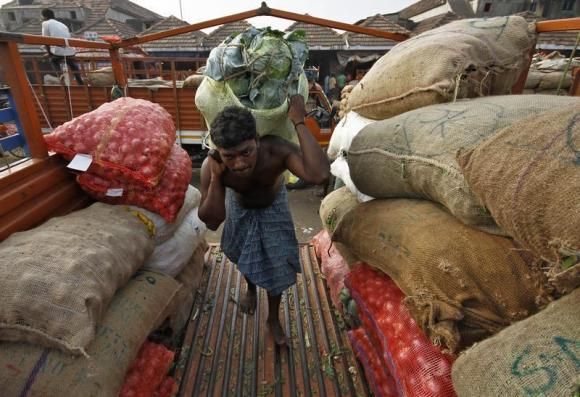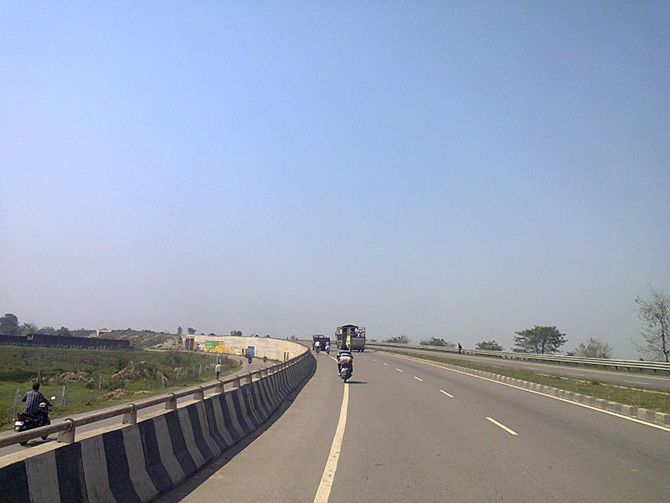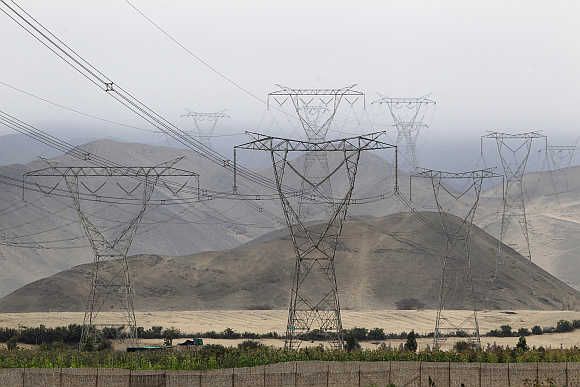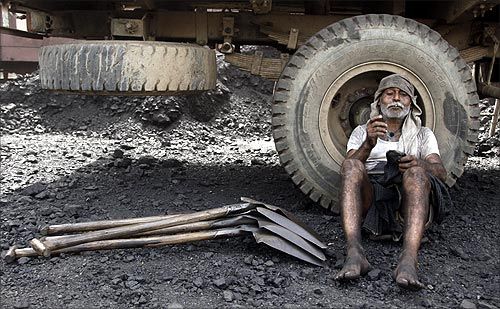 | « Back to article | Print this article |
Apart from inadequate infrastructure, which must be well-orchestrated to achieve supportive ecosystems for investment and operations, the tax-claims fallout continues to undermine growth prospects.

On the face of it, several developments augur well for the economy.
But major systemic flaws persist that must be overcome.
Some gains have resulted from Prime Minister Narendra Modi's direct selling and "heavy lifting", as in eliciting Japanese investments.
Others, such as the drop in petroleum and commodity prices, are attributable to extraneous factors.
The positive developments that seem to be coalescing into a glow on the economic horizon include: The revival of stalled projects A reduction in raw material costs, with oil prices now well under $90 a barrel Significant investments from Japan's SoftBank in Snapdeal and Ola; other significant investments and announcements in e-commerce, fort example, Flipkart and Amazon The implementation of electronic toll collection (ETC) on our highways.
Introduced between Ahmedabad and Vadodara on National Highway-8 (NH-8) in 2013, the ETC became available last week between Delhi and Mumbai on the NH-8.

It is expected to be available on all national highways in the next two months. Vehicles with prepaid tags can drive through without slowing down, whereas until now, all vehicles had to stop to pay tolls.
The productivity gains will be enormous, with fuel savings across toll stations estimated at Rs 60,000 crore or Rs 600 billion.
But all is not entirely well.
The fiscal deficit is at 80 per cent of what was budgeted for the full year; there was a decline in projects completed in the September quarter; and there is uncertainty about growth rates.
The real issue, though, is that major systemic flaws persist, resulting in growing economic and operating constraints.
There are the problems of retrospective tax claims, of coal allocation and of spectrum allocation.
In the societal dimension, there are continuing indications of disharmony, resulting in wariness and insecurity about whether we have a unifying or divisive top leadership, let alone rank and file.

Proceeding with business as usual with the present ineffective ways will lead to continuing and increasingly overwhelming detrimental effects.
Each of these areas needs breakthroughs to achieve convergent, synergistic results.
Over 60 per cent of stalled projects tracked by the Performance Management Group in the Cabinet secretariat are power projects, held up because coal is not available.
Coal-mining rights are to be auctioned on the lines of spectrum. What are the likely outcomes? While the government was jubilant about funds collected from the auctions, this created enormous capital and operating constraints for the communications sector.
This is because the Rs 1.05 lakh crore (Rs 1.05 trillion) bid for spectrum became unavailable for network construction and operations, and the limited bandwidth available to each operator adds to costs and restricts delivery capability.
Growth in network capacity has deteriorated to the point where we have higher levels of dropped calls in metros, with continuing poor broadband access countrywide.

The effects on productivity are ruinous. What can we expect from mining rights auctions?
If the results are as for the spectrum auctions, we'll have high treasury collections, high life-cycle project costs affecting critical inputs like electricity, steel and aluminium, and a reduction in investment in mining operations and downstream manufacturing.
These are logical outcomes: the consequence of higher costs is either higher prices, or financial under-recovery leading to collapse, and capital used for auctions is unavailable for investment.
Instead, what we really want from the mining allocation is inexpensive electricity and efficient production of industrial materials, such as steel and aluminium.
The financial insolvency of our state electricity boards reflects the magnitude of the problem.
Even the story of Gujarat's electricity distribution raises questions for the rest: Gujarat's average farm tariff is under Rs 1 a unit, compared with a non-farm tariff of Rs 4-5.
The high cost of providing these connections is unviable with the low revenue of 56 paise a unit.

This is why there is a backlog of about 400,000 farmers waiting for connections despite Gujarat's "surplus" of over 2,000 megawatts.
Distributing electricity at such low rates is simply unsustainable, and the situation is much worse in states providing free electricity.
A possible way to approach this is to appoint two or three individuals with the integrity and competence to work with the government, industry and experts to develop an allocation plan.
If this "beauty-parade" approach seems too utopian or academic for India, please be aware that this is precisely how land acquisition was actually done for the Calcutta Metro around 1982 after years of delay, and for part of the Bangalore Metro in 2006.
The spectrum constraints, meanwhile, show in the high levels of dropped calls because of congested lines, and the slow rollout of networks into rural areas.
This slowness is because of the unfavourable economics: of high cost and difficult execution, with lower revenue potential.
What we want from spectrum allocation is access to broadband networks at prices that will result in productivity gains.

Instead, we have neither adequate broadband networks, nor sufficiently widespread access for productivity.
A better solution is pooled networks with mandatory shared access on payment, with the government getting a share of revenues.
Apart from inadequate infrastructure, logistics, finance and regulations, all of which must be well-orchestrated to achieve supportive ecosystems for investment and operations, the tax-claims fallout continues to undermine growth prospects.
While the Vodafone problem may be finally resolved, the closure of Nokia's manufacturing facility in Chennai because of tax claims undercuts all the sales talk.
Each sector needs a supportive ecosystem, integrated with the rest.
Above all, social disharmony seriously affects our capacity for collective action.
Social coherence is essential for constructive development.
The leadership's effectiveness in reaching out and inspiring constructive aspirations can help to harmonise and channel citizens towards desirable common goals.
Such collective initiatives would reduce our fractiousness and infighting, making win-win outcomes more possible.
The solutions in all these areas need to be path-breaking, based on integrity, trust and bold, collaborative action.
We have to learn these ways.